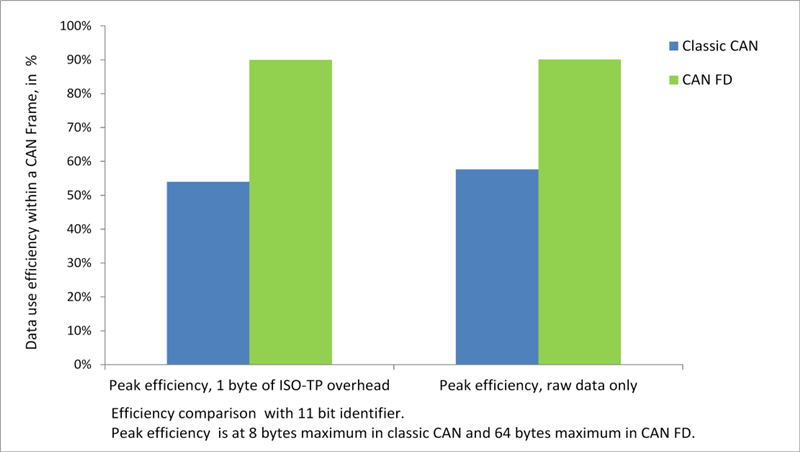SSZTAH3 january 2017 TCAN1042-Q1 , TCAN4550-Q1
Most discussions about Controller Area Network with Flexible Data Rate (CAN FD) invariably revolve around its most distinctive feature – increased speed. Naturally, this leads to the assumption that if you don’t need the speed, then you don’t need FD. But that is not always true! Join me as I take a look at a couple of the lesser-known features of CAN FD that some applications, such as Flash programming, motor drives, position sensors can still benefit from.
Bigger Payload Size
 Figure 1 Comparison of Peak Data Utilization between Classic CAN and CAN FD
Figure 1 Comparison of Peak Data Utilization between Classic CAN and CAN FDThese combined efficiency improvements in FD are independent of speed and purely a function of data payload size. The advantages build up progressively as the payload size increases and peaks at the maximum payload. So if you have to stick to bit rates <1Mbps but need to transmit payloads more than 8 bytes apiece, give FD a second look.
Improved Error Handling and CRC Checking
The underlying algorithms have also improved significantly. The bit-stuffing implementation is more robust and now incorporates dynamic stuffing, a stuff count parameter and fixed stuff bits in the CRC field of the CAN frame. All of these additions now provide the receiving node with extra information to cross-check and confirm the validity of an incoming frame. Thanks to these enhancements, a few corner cases of two-bit errors (bit flips) that were undetectable in the old standard are now detectable in FD.
What does all of this mean? The probability of an undetected bit error goes down significantly across the board. Applications operating in harsh electrical environments with very high noise (coming from big motor drives in the vicinity, for example) or with very large common-mode shifts stand to benefit from these improvements at the protocol level. Even better, the benefits of the new CRC algorithms are realized at all data rates.
Far from being a one-dimensional speed upgrade, the new CAN FD standard is well-rounded and offers advantages in a wide variety of applications. Check out our entire CAN transceiver portfolio and consider how you can leverage all the benefits of CAN FD in your next system design.
Additional Resources
- Learn more about the TCAN1042-Q1 CAN FD transceiver.
- Start designing quickly with the TCAN1042D Controller Area Network (CAN) Evaluation Module.
- For questions, contact us on the TI E2E™ Community Interface forum.